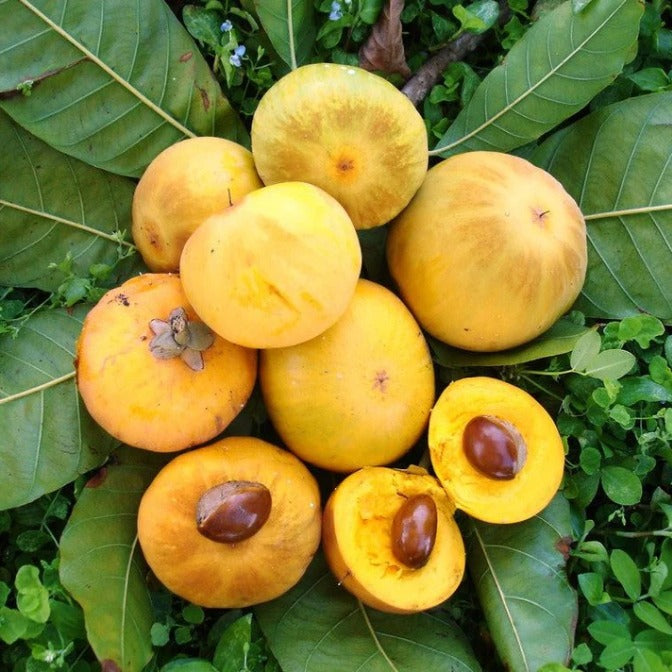Love it? Add to your wishlist
Your favorites, all in one place. Shop quickly and easily with the wishlist feature!
[message]
[title]
[message]

Veliyath Gardens
Couldn't load pickup availability
A Silken Bite of the Tropics: The Ross Sapote (Pouteria sp.)
Common Name: Ross Sapote
Botanical Name: Pouteria sp.
A Rare Delight from the Tropics
Among the unique fruiting trees of the tropical and subtropical world, the Ross Sapote stands out as a symbol of elegance and flavour. Scientifically classified under Pouteria sp., this exceptional fruit tree traces its roots back to Central America, particularly found in regions of Costa Rica, Belize, and southern Mexico. Though rare, it’s gradually gaining popularity among fruit connoisseurs and plant enthusiasts across continents due to its remarkable taste, creamy consistency, and health-enhancing qualities.
Unlike many tropical fruits, Ross Sapote surprises with its reliability in both flavor and texture. It is often harvested in autumn but is known to occasionally produce fruit in multiple seasons, depending on the climatic conditions and care provided.
Local Names and Global Reach
While internationally it is known as Ross Sapote, this fruit is also recognized under local or regional variants in certain countries:
In Costa Rica and surrounding regions, it is sometimes loosely referred to as Zapote Amarillo.
In parts of the United States, especially Florida where it has been introduced, it retains the name Ross Sapote, but is sometimes confused with its relative, the Canistel.
In India, plant collectors and rare fruit enthusiasts have started to refer to it affectionately as “Pumpkin Fruit” due to its texture and appearance.
Despite its rarity, the Ross Sapote is steadily making its way into private orchards, collector gardens, and boutique nurseries—especially those with a passion for exotic fruit species.
A Taste Worth Remembering
The Ross Sapote fruit is visually striking—rounded and smooth-skinned, with a vivid golden-orange interior that captures the warmth of the tropics. What truly sets it apart, however, is its silky texture and luscious flavour.
The flesh is creamy and custard-like, reminiscent of pumpkin pie or flan, yet lighter and smoother.
Its flavor profile carries delicate caramel undertones, combined with a subtle sweetness that appeals even to those who typically shy away from rich fruits.
It lacks the dryness often found in other members of the sapote family, offering instead a buttery, melt-in-the-mouth experience that makes it perfect for direct consumption or blending into sweet dishes.
Nutritional and Health Benefits
This tropical treasure is not just about indulgence—it’s also packed with natural nutrients that support overall well-being:
Vitamin A – Promotes eye health and strengthens the mucous membranes, providing the body’s first defense against pathogens.
Vitamin C – A known immune booster, it also plays a role in collagen formation and antioxidant protection.
Potassium – Supports cardiovascular health and helps maintain fluid balance.
Fiber – Encourages digestive health and stabilizes blood sugar levels.
Natural Sugars – Provide sustained energy, making it a good snack choice for children and adults alike.
Traditionally, the fruit has been used in folk remedies for its cooling properties and digestive ease, especially in tropical climates.
Cultivation and Plant Maintenance
Growing a Ross Sapote plant is a satisfying venture, especially for those who appreciate unique additions to their garden. Here are the key features of its cultivation:
Type: Grown from seedling
Blooming/Fruiting Period: Begins producing fruit in 3 to 4 years
Tree Type: Evergreen, small to medium-sized
Maintenance: Moderate care needed – prefers regular watering and light pruning
Climate: Tropical to subtropical environments; requires protection from frost
Soil Requirements: Well-drained, organic-rich soil with slightly acidic to neutral pH
Sunlight Needs: Full sun for best fruit production, though partial shade is tolerated
This plant thrives best in garden spaces that allow for proper drainage and warmth. Applying mulch helps in moisture retention and root insulation. Fertilization with compost or organic matter during the growing season enhances fruit quality.
Preservation and Storage
Due to its delicate flesh, the fruit is best consumed soon after harvest. However, it can be preserved and enjoyed in various ways:
Refrigeration: Keeps well for 3–4 days if uncut
Pureeing: The pulp can be mashed and frozen for use in smoothies or desserts
Culinary Uses: Excellent for puddings, smoothies, pies, or as a natural sweetener in baked goods
Preserves: Can be turned into jams or fruit butter for longer storage
Its texture makes it ideal for baby foods and natural dessert bases, especially for those seeking alternatives to artificial sweeteners or dairy.
Tradition and Emerging Popularity
While not historically cultivated on a large scale, the Ross Sapote has begun to gain appreciation among boutique fruit growers, health-conscious gardeners, and those with an interest in rare fruit varieties. Its resemblance to more common sapotes in shape, yet its superior flavor and texture, make it a collector’s delight.
In small farming communities across Central America, the fruit is often shared fresh among families, and its seeds are traditionally preserved for propagation. Its rarity and unique taste have contributed to its status as a hidden gem of the tropics.
Adding Ross Sapote to Your Daily Life
Incorporating Ross Sapote into one’s diet is more than just enjoying a fruit—it’s embracing a tradition of wholesome nourishment:
Enjoy it as a post-meal dessert to satisfy sweet cravings naturally.
Blend it with bananas or mangoes for a nutritious smoothie.
Use it in breakfast bowls or as a creamy filling for healthy pastries.
For those who enjoy gardening, watching the plant thrive and fruit in your own backyard brings not just harvest but year-round joy.
Its rich nutrients, easy-to-digest nature, and fragrant flavor make it suitable for people of all age groups—from toddlers to the elderly.
Why Ross Sapote Deserves a Place in Your Garden
When you plant a Ross Sapote, you’re not just growing fruit—you’re cultivating an experience. It promises beauty in form, delight in taste, and wellness in every bite. For those seeking something different yet rewarding, this plant offers a journey of flavors that reconnect you with nature’s gentle abundance.
At Veliyath Gardens, we bring you carefully nurtured Ross Sapote seedling plants, ready to adapt to your space and grow with care. Our commitment to rare fruit plants ensures that when you choose from us, you’re investing in quality, passion, and authenticity.
Let the creamy sweetness of Pouteria sp. become part of your garden and your lifestyle. It’s more than a fruit—it’s a fragrant whisper from the tropics, calling you to taste and nurture life in its most delightful form.
Maintenance: Moderate care needed – prefers regular watering and light pruning
Climate: Tropical to subtropical environments; requires protection from frost
Soil Requirements: Well-drained, organic-rich soil with slightly acidic to neutral pH
Sunlight Needs: Full sun for best fruit production, though partial shade is tolerated
Vitamin A – Promotes eye health and strengthens the mucous membranes, providing the body’s first defense against pathogens.
Vitamin C – A known immune booster, it also plays a role in collagen formation and antioxidant protection.
Potassium – Supports cardiovascular health and helps maintain fluid balance.
Enjoy it as a post-meal dessert to satisfy sweet cravings naturally.
Blend it with bananas or mangoes for a nutritious smoothie.
Use it in breakfast bowls or as a creamy filling for healthy pastries.


